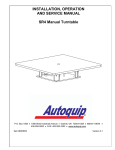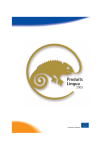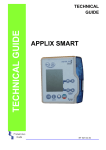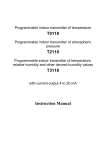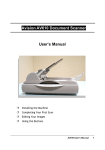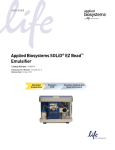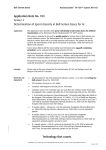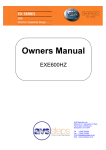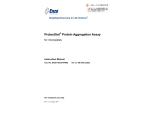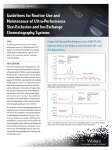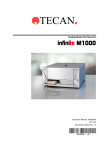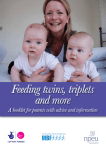Download Cytiva™ Plus Cardiomyocytes - GE Healthcare Life Sciences
Transcript
Cytiva™ Plus Cardiomyocytes Product booklet Codes: 29-0918-80 ≥1 × 106 (1 000 000) viable cells 29-0918-81 ≥3.5 × 106 (3 500 000) viable cells Page finder 1. Legal 4 2. Handling 2.1. Safety warnings and precautions 2.2. Storage 2.3. Expiry 2.4. Packaging 6 6 6 7 7 3. Introduction 8 4. Components and other materials required 4.1. Components 4.2. Materials to be supplied by user 4.3. Equipment needed 9 9 9 10 5. Protocols for MEA 5.1. Preparation of MEA coated plates (Time 4 hours) 5.2. Preparation of RPMI 1640/B27 medium for MEA (Time 30 minutes) 5.3. Thawing of Cytiva Plus Cardiomyocytes for MEA (Time 30 minutes) 5.4. D etermining Post-Thaw Cell Viability of Cytiva Plus Cardiomyocytes for MEA (Time 30 minutes) 5.5. Seeding Cytiva Plus Cardiomyocytes onto MEA plates (Time 3 hours) 5.6. Media change on day 4 post-thaw (Time 20 minutes) 11 11 13 6. Protocols for HCA 6.1. Preparation of cell culture plates for HCA (Time 2½ hours) 6.2. Preparation of RPMI 1640/B27 medium for HCA (Time 20 minutes) 6.3. Thawing of Cytiva Plus Cardiomyocytes for HCA (Time 30 minutes) 2 14 15 18 20 22 22 6.4. D etermining Post-thaw Cell Viability of Cytiva Plus Cardiomyocytes for HCA (Time 30 minutes) 6.5. Seeding Cytiva Plus Cardiomyocytes into cell culture plates for HCA (Time 30 minutes) 6.6. Media change on day 4 post-thaw (Time 20 minutes) 25 7. Protocols for manual patch clamp 7.1. Sterilization of glass coverslips (Time 4 hours) 7.2. Preparation of 1:2 diluted Matrigel aliquots (Time 10 minutes with O/N thaw) 7.3. Preparation of 1:30 diluted Matrigel (Time 10 minutes) 7.4. Preparation of Matrigel-coated coverslips (Time 10 minutes) 7.5. Preparation of RPMI 1640/B27 medium for manual patch clamp (Time 20 minutes) 7.6 Thawing Cytiva Plus Cardiomyocytes for manual patch clamp (Time 30 minutes) 7.7. D etermination of post-thaw viability of Cytiva Plus Cardiomyocytes for manual patch clamp (Time 30 minutes) 7.8. Seeding Cytiva Plus Cardiomyocytes onto coverslips (Time 30 minutes) 7.9. Media change on day 4 post-thaw (Time 20 minutes) 31 31 32 8. Troubleshooting 43 9. Related products 46 23 24 3 28 29 33 34 35 36 37 39 41 1. Legal GE, GE monogram and imagination at work are trademarks of General Electric Company. Cytiva is a trademark of General Electric Company or one of its subsidiaries. B27 and KnockOut are trademarks of Gibco. Matrigel is a trademark of Becton, Dickinson and Company. NucleoCounter, NucleoCassette and NC-100 are trademarks of Chemometec A/S. μClear is a registered trademark of Greiner Bio-One GmbH. All other third party trademarks are the property of their respective owner. License statements Notice to purchaser: Important license information. The purchase of Cytiva Plus Cardiomyocytes includes a limited license to use the Cytiva Plus Cardiomyocytes for internal research and development, but not for any commercial purposes. Commercial purposes shall include: sale, lease, license or other transfer of the material or any material derived or produced from it; sale, lease, license or other grant of rights to use this material or any material derived or produced from it; use of this material to perform services for a fee for third parties. A license to use the Cytiva Plus Cardiomyocytes for commercial purposes is subject to a separate license agreement with GE Healthcare. IF YOU REQUIRE A COMMERCIAL LICENSE TO USE THIS MATERIAL AND DO NOT HAVE ONE PLEASE CONTACT YOUR LOCAL GE HEALTHCARE REPRESENTATIVE AND RETURN THIS MATERIAL, UNOPENED TO GE HEALTHCARE UK LTD, THE MAYNARD CENTRE, FOREST FARM, WHITCHURCH, CARDIFF CF14 7YT, UK AND ANY MONEY PAID FOR THE MATERIAL WILL BE REFUNDED. 4 GE Healthcare Cytiva Plus Cardiomyocytes (the Products) are sold under licence from Asterias Biotherapeutics Inc., and Wisconsin Alumni Research Foundation (WARF) under US patent and publication numbers: US 5,843,780, US 6,200,806, US 6,602,711, US 6,800,480, US 7,005,252, US 7,029,913, US 7,297,539, US 7,413,902, US 7,425,448, US 7,452,718, US 7,582,479, US 7,732,199, US 7,763,464, US 7,781,216, US 7,851,167, US 7,897,389 and US 2007/0010012 and equivalent patent and patent applications in other countries. Important note: For in vitro research use only. Not to be used for any therapeutic or diagnostic applications. Not recommended or intended for diagnosis of disease in humans or animals. Do not use internally or externally in humans or animals. © 2014 General Electric Company – All rights reserved. First published April 2014 All goods and services are sold subject to the terms and conditions of sale of the company within GE Healthcare which supplies them. A copy of these terms and conditions is available on request. Contact your local GE Healthcare representative for the most current information. http://www.gelifesciences.com GE Healthcare UK Limited. Amersham Place, Little Chalfont, Buckinghamshire, HP7 9NA, UK 5 2. Handling 2.3. Expiry A Material Safety Data Sheet (MSDS) for the dimethyl sulphoxide (DMSO) in which Cytiva Plus Cardiomyocytes are frozen, is included with this shipment and available at http://www.gelifesciences.com/ msds. safety glasses and gloves. Care should be taken to avoid contact with skin or eyes. In the case of contact with skin or eyes wash immediately with water. See material safety data sheet(s) and/or safety statement(s) for specific advice. 2.1. Safety warnings and precautions 2.2. Storage Please refer to the Certificate of Analysis for further details. 2.4. Packaging Cytiva Plus Cardiomyocytes are provided as cryopreserved single cell suspensions in 1 ml cryovials. Cytiva Plus Cardiomyocyte product codes 29-0918-80 and 29-0918-81 are supplied in 1 ml cryovials of ≥1 × 106 (1 000 000) viable cells (1.6 × 106 total cells) and ≥3.5 × 106 (3 500 000) viable cells (5 × 106 total cells) respectively, cryopreserved in 10% DMSO and 90% foetal bovine serum. Upon receipt, the frozen vial(s) of cells should immediately be removed from the outer packaging and transferred to the vapor phase of a liquid nitrogen storage unit at -140°C. Warning: For research use only. Not recommended or intended for diagnosis of disease in humans or animals. Do not use internally or externally in humans or animals. All chemicals should be considered as potentially hazardous. We therefore recommend that this product is handled only by those persons who have been trained in laboratory techniques and that it is used in accordance with the principles of good laboratory practice. Wear suitable protective clothing such as laboratory overalls, 6 7 3. Introduction GE Cytiva Plus Cardiomyocytes are human cardiomyocytes derived from the NIH approved stem cell line NIH hESC-10-0061. Cytiva Plus Cardiomyocytes have been extensively characterized and functionally verified by flow cytometry, sub-cellular imaging and electrophysiology. Cytiva Plus Cardiomyocytes are supplied cryopreserved in a ready to use format. 4. Components and other materials required 4.1. Components • GE Cytiva Plus Cardiomyocytes • Certificate of Analysis including product specifications • Material Safety Data Sheet • User manual 4.2. Materials to be supplied by user Product Supplier/Product code 15 ml Centrifuge tubes Corning 430052 50 ml Centrifuge tubes Corning 430290 Serological pipettes – 5 ml Corning 4487 Serological pipettes – 10 ml Corning 4488 Serological pipettes – 25 ml Corning 4489 500 ml Cellulose acetate filter units Corning 430769 12- or 48-well MEA plate e.g. Axion BioSystems (for MEA applications) M768-GLx or M768-KAP-48 Multi-well cell culture plates Various e.g. 96-well culture plate (for HCA and Ca2+ transient (Greiner µClear™) 781091 applications) Multi-well plates for impedance e.g. ACEA E-plate Cardio 96 applications Coverslips - electrophysiological applications* VWR 631-0149 1.5 ml tubes Corning 430290 Sterile bottle (e.g. 30 or 60 ml) NALG2019-0030/0060 * –not available in North America. Standard glass coverslips of approximately 13 mm diameter and 0.13 mm thickness are suitable. 8 9 Product RPMI 1640 + Glutamine D-PBS B27 (50×) Fibronectin FBS Matrigel™ KnockOut™ D-MEM (KO-DMEM) Sterile distilled water Supplier/Product code Gibco 21875034 Sigma D8537 Gibco 17504-004 BD Biosciences 354008 Gibco 26140-079 Becton Dickinson 356231 Gibco 10829-018 Fresenius Kabi 22-96-985 4.3. Equipment needed Adjustable pipettes and tips Liquid nitrogen vapour store Biosafety cabinet Ice bucket with dry ice Cryovial rack Vacuum pump and line Hemocytometer or automated cell counter 37°C water bath Centrifuge Application dependent: Patch clamp system Sub-cellular imaging system for High Content Analysis Multi electrode array system Impedance system Calcium transient system 5. Protocols for MEA 5.1. Preparation of MEA coated plates (Time 4 hours) Consumables • FBS (at 4°C) • Sterile distilled H2O • Fibronectin (1 mg, human, BD Biosciences 354008) (at 4°C) • 50 ml tube • D-PBS Equipment • MEA plate (e.g. Axion BioSystems 12 well plate) • 20 µL pipette & sterile 1-20 µL tips • 1000 µL pipette & sterile 1-1000 µL tips Protocol Perform the following steps aseptically inside the biosafety cabinet (BSC). The first step in preparing an MEA plate for use is to ensure that the surface is hydrophilic. The surface of a new MEA plate is hydrophobic, and even hydrophilic MEAs tend to become hydrophobic again during storage. A hydrophobic surface will prevent attachment and growth of the (hydrophilic) cells. FBS treatment renders the surface hydrophilic. 1. Place a 4 µL bead of FBS over the recording electrode area of each well of the MEA plate (see Fig 1). Note: If a bead fails to form, ignore that recording site. 2. For a 12 well MEA plate, add 500 µL of sterile distilled H2O to the gaps between the wells to prevent the evaporation of the bead of FBS (see Fig 1). For a 48 well MEA plate add 200 µL of sterile distilled H2O to the gaps between the wells. 10 11 3.Put the lid on the MEA plate and incubate the MEA plate for 1.5 hours at room temperature. 4. Prepare a 1 mg/ml solution of fibronectin by adding 1 ml sterile distilled H2O to the 1 mg fibronectin. 5.Take 12.5 µL of this 1 mg/ml fibronectin solution and add it to 987.5 µL D-PBS in a 50 ml tube for a final concentration of 12.5 µg/ml fibronectin. 6. Aspirate the FBS bead from each well of the MEA plate (use a pipette set to dispense 8 µL) and immediately replace with a 4 µL bead of 12.5 µg/ml fibronectin solution over the recording electrode area. 7. Put the lid on the tissue culture dish and incubate the MEA plate for 2 hours in a standard cell culture incubator at 37°C. 500 µL H2O 5.2. Preparation of RPMI 1640/B27 medium for MEA (Time 30 minutes) Consumables • RPMI 1640 + Glutamine medium, 500 ml (at 4°C) • B27™ supplement, 10 ml (at 4°C) • 10 ml sterile serological pipette Equipment • 500 ml 0.22 µm cellulose acetate filter unit (Corning 430769) • Vacuum line • Pipette gun Protocol During the 2 hour fibronectin incubation step, prepare medium. Note: Medium may be prepared immediately before thawing Cytiva Plus Cardiomyocytes or prepared and stored at 2–8°C and used within one week of preparation. 1. Thaw frozen 10 ml B27 supplement vial(s) in a 37°C water bath for 10 minutes. Do not incubate at 37°C or expose to light for extended periods of time. Perform the following steps aseptically inside the biosafety cabinet (BSC). Figure 1. 12 well MEA plate showing location of sterile water addition to the inter-well space to prevent evaporation of the FBS and fibronectin drop. 2.Wipe the required number of RPMI 1640 + Glutamine medium bottle(s) and B27 Supplement vial(s) with 70% isopropanol and transfer to a BSC. 3. Place the filtration unit into the BSC. 4.Using a 10 ml sterile serological pipette, add 10 ml of B27 supplement to a 500 ml bottle of RPMI1640 + Glutamine medium. Swirl bottle several times to mix. 5.Carefully transfer the medium and supplement into the reservoir of the filter unit. 12 13 6. Place the lid on the filter unit. 7. Connect the filter unit to a vacuum source. 8. When filtration is complete, disconnect the vacuum source. 9. Detach the upper reservoir of the filtration unit. 10.Place sterile cap on the bottle portion of the filter unit. Note: Store the medium at 2–8°C. Use within one week of preparation. Avoid repeated warming of the RPMI 1640/ B27 medium. Warm only the required volume of medium to complete the task. 5.3. Thawing Cytiva Plus Cardiomyocytes for MEA (Time 30 minutes) Consumables • 3.5 × 106 vial of Cytiva Plus Cardiomyocytes • RPMI 1640/B27 medium (filter sterilized) • 50 ml tube • 10 ml sterile serological pipette Equipment • Ice bucket with dry ice • Cryovial rack • 37°C water bath • Centrifuge • 1000 µL pipette & sterile 1-1000 µL tips • Pipette gun Protocol During the 2 hour fibronectin incubation step, perform the following steps aseptically inside the biosafety cabinet (BSC). 1.Remove the cryovial from the cryostore and place onto dry ice until ready to thaw. 14 2.Thaw cell suspension in a 37°C water bath with gentle agitation until ice crystals just disappear. Note: Take care not to immerse the whole cryovial into the water bath. Avoid extended incubation at 37°C. 3.Wipe the outside of the cryovial with 70% isopropanol and transfer to BSC. 4.Carefully transfer the cell suspension into a sterile 50 ml centrifuge tube using a 1000 µL pipette. 5.Rinse the inside of the cryovial with 1 ml of room temperature RPMI 1640/B27 and combine with the cell suspension drop-wise with gentle mixing. 6.Slowly (over the course of 2 minutes) add 8 ml of RPMI 1640/B27 to the 50 ml centrifuge tube. 7. Centrifuge at 300 g for 5 minutes at 20°C. 8.Carefully, using a 10 ml stripette remove 8 mls of the supernatant. Remove a further 1 ml with a 1000 µL pipette taking care not to disturb the cell pellet. Resuspend the cells in the residual liquid (approx. 1 ml) with gentle agitation. 5.4. Determining Post-Thaw Cell Viability of Cytiva Plus Cardiomyocytes for MEA (Time 30 minutes) During the 2 hour fibronectin incubation step, determine the viable cell number and viable cell density using preferred method of choice. A method for the NucleoCounter™ NC-100™ (ChemoMetec) cell counter is outlined below. However, this method could be adapted for other commercial cell counters. 15 Consumables • RPMI 1640/B27 medium (filter sterilized) • 4 × 1.5 ml tubes • 4 × NucleoCassettes™ (ChemoMetec) • Reagent A100 (ChemoMetec) • Reagent B (ChemoMetec) Equipment • 100 µL pipette & sterile 1-200 µL tips • 1000 µL pipette & sterile 1-1000 µL tips • NucleoCounter NC-100 (ChemoMetec) Protocol Perform the following steps aseptically inside the biosafety cabinet (BSC). 1.Determine viable cell number using the NucleoCounter NC-100 (ChemoMetec). To do this, transfer 40 µL of the cell suspension into a 1.5 ml tube. Add to the tube 360 µL of RPMI 1640/B27 medium (i.e. now a 1:10 dilution). Gently agitate to achieve an even cell suspension. 2. The remaining steps can be performed outside of the BSC. 3.Transfer 100 µL of 1:10 diluted cell suspension into each of three more 1.5 ml tubes. 7. Repeat step 6 for a second time, and calculate the average result. 8.Determine the total Volume of Cell Suspension. Note: We use a 1000 µL pipette to establish this volume. 9. Calculate the number of viable cells in the cell suspension: Viable cells/ml = 10 × [(3 × Total Number of Cells/ml) - (Non-Viable Cells/ml)] Total number of viable cells = Viable cells/ml × Volume of Cell Suspension (ml) Worked example for a typical 3.5 × 106 vial of Cytiva Plus Cardiomyocytes: Total Number of Cells/ml determined in step 6 = 1.83 × 105 Non-Viable Cells/ml determined in step 5 = 1.64 × 105 Viable cells/ml = 10 × [(3 × 1.83 × 105) - (1.64 × 105)] = 3.85 × 106 cells/ml Total number of viable cells = 3.85 × 106 cells/ml × 1 ml = 3.85 × 106 cells Note: There are a total of 5.5 × 106 cells in a 3.5 × 106 vial of Cytiva Plus Cardiomyocytes and we routinely record a value of >70% post thaw cell viability (i.e. 3.85 × 106 viable cells). 4.Use a 100 µL of 1:10 diluted cell suspension sample to calculate the number of Non-Viable Cells/ml (i.e. directly load the sample into a NucleoCassette). 5. Repeat step 4 for a second time, and calculate the average result. 6.Use another 1 × 100 µL of 1:10 diluted cell suspension sample to calculate the Total Number of Cells/ml. To do this, add 100 µL of Reagent A100, and then 100 µL of Reagent B, to the 100 µL of 1:10 diluted cell suspension sample. Mix by pipetting, then load into a NucleoCassette. 16 17 5.5. Seeding Cytiva Plus Cardiomyocytes onto MEA plates (Time 3 hours) 6.Dilute the cell suspension to 1.5 × 107 viable cells/ml using warm RPMI 1640/B27 medium. Cells should be seeded at a density of 6 × 104 viable cells in 4 µL (i.e. 1.5 × 107 viable cells/ml) over the recording electrode area. Required volume (ml) = Note: Assuming the volume of the cell suspension is ~1 ml, and the number of viable cells is 3.85 × 106, the current concentration is ~3.85 × 106 viable cells/ml. Consequently the next step involves centrifuging and resuspending the cells from section 5.4 to achieve the appropriate cell concentration. Note: Assuming number of viable cells is 3.85 × 106, the volume should be made up to 260 µL. Remove fibronectin-coated well MEA plate from incubator. Consumables • RPMI 1640/B27 medium (filter sterilized) • 50 ml tube • 60 ml bottle Viable cells 1.5 × 107 viable cells/ml 8.Aspirate the fibronectin bead from each well of the MEA plate (use a pipette set to dispense 8 µL) and immediately replace with a 4 µL bead of Cytiva Plus Cardiomyocyte suspension (1.5 × 107 viable cells/ml) over the recording electrode area (see Fig 2). Equipment • Fibronectin coated well MEA plate • 20 µL pipette & sterile 1-20 µL tips • 200 µL pipette & sterile 1-200 µL tips • 1000 µL pipette & sterile 1-1000 µL tips Cytiva Plus bead of cells Protocol Perform the following steps aseptically inside the biosafety cabinet (BSC). 1. Warm 25 ml RPMI 1640/B27 medium in a 60 ml bottle (sealed) in a 37°C water bath. 2.Centrifuge the cell suspension in a 50 ml tube at 300 g for 5 minutes at 20°C. 3. Carefully, using a 1000 µL pipette, remove the supernatant. 4. Resuspend the cells in the residual liquid with gentle agitation. 5. Determine the total volume of the cell suspension. Figure 2. Fibronectin bead replaced with Cytiva Plus cardiomyocyte bead. 9.After seeding all wells, put the lid on the tissue culture dish and incubate the MEA plate in a standard cell culture incubator at 37°C for 2–3 hours. The sterile distilled water in the gaps between the wells will prevent the evaporation of the bead of cell suspension. Note: We use a 100 µL pipette to establish this volume. 18 19 10.After 2–3 hours, gently add 500 µL of warm RPMI 1640/B27 medium to the ‘corner’ of each well of the 12-well MEA plate or 150 µL of warm RPMI 1640/B27 medium to the ‘corner’ of each well of the 48-well MEA plate. Pipette against the side of the well so as not to disturb the plated cells. 11.Gently add another 500 µL of warm RPMI 1640/B27 medium to the ‘corner’ of each well of the 12-well MEA plate or 150 µL of warm RPMI 1640/B27 medium to the ‘corner’ of each well of the 48-well MEA plate. 12.Gently add another 1000 µL of warm RPMI 1640/B27 medium to the ‘corner’ of each well of the 12-well MEA plate (i.e. total well volume is now 2 ml) or another 150 µL of warm RPMI 1640/B27 medium to the ‘corner’ of each well of the 48-well MEA plate (i.e. total well volume is now 450 µL). to the ‘corner’ of each well of the 12-well MEA plate, to give a total volume of 2 ml. 4.For the 48-well plate, using a 1000 µL pipette, carefully aspirate 250 µL of media from each well of the 48-well MEA plate then using a 200 µL pipette, gently add 200 µL of warm RPMI 1640/B27 medium to the ‘corner’ of each well of the 48-well MEA plate, to give a total well volume of 400 μL. 5.Perform MEA recordings 5–7 days after plating onto the MEA plate. It is the responsibility of the user to determine the optimal culture time for this application. 13.Aspirate the 500 µL of sterile distilled H2O from the gaps between the wells in the 12-well MEA plate or 200 µL of sterile distilled H2O from the gaps between the wells in the 48-well MEA plate. 14.Confirm cell attachment at this point by observing the MEA wells under the microscope if using a transparent plate (see Fig 3A and 3B). 15.Incubate in a standard cell culture incubator at 37°C, 5% CO2. 5.6. Media change on day 4 post-thaw (Time 20 minutes) 3A 3B Figure 3A – Wells containing Cytiva Plus Cardiomyocytes and media. Figure 3B – Cytiva Plus Cardiomyocytes as viewed under a microscope, 5 days after seeding. 1.Warm 30 ml RPMI 1640/B27 medium in a 60 ml bottle (sealed) in a 37°C water bath. 2.Perform the following steps aseptically inside the biosafety cabinet (BSC). 3.For the 12-well MEA plate, using a 1000 µL pipette, carefully aspirate 1000 µL of media from each well of the 12-well MEA plate, then gently add 1000 µL of warm RPMI 1640/B27 medium 20 21 6. Protocols for HCA 6.1. Preparation of cell culture plates for HCA (Time 2½ hours) Consumables • Sterile distilled H2O • Fibronectin (1 mg, human, BD Biosciences 354008) (at 4°C) • 50 ml sterile tube • D-PBS (sigma D8537) Equipment • 384–well cell culture plate (e.g. Greiner µClear 781091) • 96-well cell culture plate (e.g. Greiner µClear 655090) • 20 µL pipette & sterile 1–40 µL tips • 1000 µL pipette & sterile 1–1000 µL tips Protocol Perform the following steps aseptically inside the biosafety cabinet (BSC). 1.Prepare a 1 mg/ml solution of fibronectin by adding 1 ml sterile distilled water to the 1 mg fibronectin. 2.Take 125 µL of this 1 mg/ml fibronectin solution and add it to 9875 µL D-PBS in a 50 ml tube for a final concentration of 12.5 µg/ml fibronectin. Add 100 µL of 12.5 µg/ml fibronectin solution to each well of the 96–well cell culture plate, or 30 µL to each well of a 384–well cell culture plate. 3.Put the lid on the cell culture plate and incubate for 2 hours in a standard cell culture incubator at 37°C, 5% CO2. 6.2. Preparation of RPMI 1640/B27 medium for HCA (Time 20 minutes) Consumables • RPMI 1640 + Glutamine medium, 500 ml (at 4°C) • B27 supplement, 10 ml (at -20°C) • 10 ml sterile serological pipette Equipment • 500 ml 0.22 µm cellulose acetate filter unit (Corning 430769) • Vacuum line • Pipette gun Protocol During the 2 hour fibronectin incubation step, prepare medium. Note: Medium may be prepared immediately before thawing Cytiva Plus Cardiomyocytes or prepared and stored at 2–8°C and used within one week of preparation. 1.Thaw frozen 10 ml B27 supplement vial(s) for 10 minutes in a 37°C water bath. Do not incubate at 37°C or expose to light for extended periods of time. Perform the following steps aseptically inside the biosafety cabinet (BSC). 2.Wipe the required number of RPMI 1640 + Glutamine medium bottle(s) and B27 Supplement vial(s) with 70% isopropanol and transfer to a BSC. 3. Place the filtration unit into the BSC. 4.Using a 10 ml sterile serological pipette, add 10 ml of B27 supplement to 500 ml bottle of RPMI 1640 + Glutamine medium. Swirl bottle several times to mix. 5.Carefully pour 510 ml of the RPMI 1640/B27 medium into the reservoir of the filtration unit. 22 23 6. Place the lid on the filter unit. 7. Connect the filter unit to a vacuum source. 8. When filtration is complete, disconnect the vacuum source. 9. Detach the upper reservoir of the filtration unit. 10.Place sterile cap on the bottle portion of the filter unit. Note: Store the medium at 2–8°C. Use within one week of preparation. Avoid repeated warming of the RPMI 1640/ B27 medium. Warm only the required volume of medium to complete the task. 6.3. Thawing Cytiva Plus Cardiomyocytes for HCA (Time 30 minutes) Consumables • 3.5 × 106 vial of Cytiva Plus Cardiomyocytes • RPMI 1640/B27 medium (filter sterilized) • 50 ml sterile tube • 10 ml sterile serological pipette Equipment • Ice bucket with dry-ice • Cryovial rack • 37°C water bath • Centrifuge • 1000 µL pipette & sterile 1-1000 µL tips • Pipette gun Protocol During the 2 hour fibronectin incubation step, perform the following steps aseptically inside the biosafety cabinet (BSC). 2.Thaw cell suspension in a 37°C water bath with gentle agitation until ice crystals just disappear. Note: Take care not to immerse the whole cryovial into the water bath. Avoid extended incubation at 37°C. 3.Wipe the outside of the cryovial with 70% isopropanol and transfer to BSC. 4.Carefully transfer the cell suspension into a sterile 50 ml centrifuge tube using a 1000 µL pipette. 5.Rinse the inside of the cryovial with 1 ml of room temperature RPMI 1640/B27 and combine with the cell suspension drop-wise with gentle mixing. 6.Slowly (over the course of 2 minutes) add 8 ml of RPMI 1640/B27 to the 50 ml centrifuge tube. 7. Centrifuge at 300 g for 5 minutes at 20°C. 8.Carefully, using a 10 ml stripette remove 8 mls of the supernatant. Remove a further 1 ml with a 1000 µL pipette taking care not to disturb the cell pellet. Resuspend the cells in the residual liquid (approx. 1 ml) with gentle agitation. 6.4. Determining Post-thaw Cell Viability of Cytiva Plus Cardiomyocytes for HCA (Time 30 minutes) During the 2 hour fibronectin incubation step, determine the viable cell number and viable cell density using preferred method of choice. We use a NucleoCounter NC-100 (ChemoMetec) cell counter, the method for which is outlined below. However, this method could be adapted for other commercial cell counters. 1.Remove the cryovial from the cryostore and place onto dry-ice until ready to thaw. 24 25 Consumables • RPMI 1640/B27 medium (filter sterilized) • 4 × 1.5 ml tubes • 4 × NucleoCassettes (ChemoMetec) • Reagent A100 (ChemoMetec) • Reagent B (ChemoMetec) Equipment • 100 µL pipette & sterile 1–200 µL tips • 1000 µL pipette & sterile 1–1000 µL tips • NucleoCounter NC-100 (ChemoMetec) Protocol Perform the following steps aseptically inside the biosafety cabinet (BSC). 1.Determine viable cell number using the NucleoCounter NC-100 (ChemoMetec). To do this, transfer 40 µL of the cell suspension into a 1.5 ml tube. Add to the tube 360 µL of RPMI 1640/B27 medium (i.e. now a 1:10 dilution). Gently agitate to achieve an even cell suspension. 2. The remaining steps can be performed outside of the BSC. 3.Transfer 100 µL of 1:10 diluted cell suspension into 4 × 1.5 ml tubes. 7. Repeat step 6 for a second time, and calculate the average result. 8.Determine the total Volume of Cell Suspension. Note: We use a 1000 µL pipette to establish this volume. 9. Calculate the number of viable cells in the cell suspension: Viable cells/ml = 10 × [(3 × Total Number of Cells/ml) - (Non-Viable Cells/ml)] Total number of viable cells = Viable cells/ml × Volume of Cell Suspension (ml) Worked example for a typical 3.5 × 106 vial of Cytiva Plus Cardiomyocytes: Total Number of Cells/ml determined in step 6 = 1.83 × 105 Non-Viable Cells/ml determined in step 5 = 1.64 × 105 Viable cells/ml = 10 × [(3 × 1.83 × 105) – (1.64 × 105)] = 3.85 × 106 cells/ml Total number of viable cells = 3.85 × 106 cells/ml × 1 ml = 3.85 × 106 cells Note: There are a total of 5.5 × 106 cells in a 3.5 × 106 vial of Cytiva Plus Cardiomyocytes and we routinely record a value of >70% post thaw cell viability (i.e. 3.85 × 106 viable cells). 4.Use a 100 µL of 1:10 diluted cell suspension sample to calculate the number of Non-Viable Cells/ml (i.e. directly load the sample into a NucleoCassette). 5. Repeat step 4 for a second time, and calculate the average result. 6.Use another 1 × 100 µL of 1:10 diluted cell suspension sample to calculate the Total Number of Cells/ml. To do this, add 100 µL of Reagent A100, and then 100 µL of Reagent B to the 100 µL of 1:10 diluted cell suspension sample. Mix by pipetting, then load into a NucleoCassette. 26 27 6.5. Seeding Cytiva Plus Cardiomyocytes into cell culture plates for HCA (Time 30 minutes) Cells should be seeded at a density of 3.6 × 104 viable cells in 200 µL RPMI 1640/B27 per well of a 96–well cell culture plate, or 9 × 103 viable cells in 50 µL RPMI 1640/B27 per well of a 384–well cell culture plate (i.e. 1.8 × 105 viable cells/ml). Note: Assuming the volume of the cell suspension is ~1 ml, and the number of viable cells is 3.85 × 106, the current concentration is ~3.85 × 106 viable cells/ml. Consequently the next step involves diluting the cell suspension to achieve the appropriate cell concentration. Consumables • RPMI 1640/B27 medium (filter sterilized) • 60 ml bottle Equipment • Fibronectin coated cell culture plate • 200 µL pipette & sterile 1-200 µL tip Protocol Perform the following steps aseptically inside the biosafety cabinet (BSC). 1.Warm 25 ml RPMI 1640/B27 medium in a sterile 60 ml bottle (sealed) in a 37°C water bath. 2.Dilute the cell suspension to 1.8 × 105 viable cells/ml using warm RPMI 1640/B27 medium. Required volume (ml) = Viable cells 1.8 × 105 viable cells/ml 28 Example: A total viable count of 3.85 × 106 cells would be divided by 1.8 × 105 viable cells/ml to obtain a final required volume of 21.4 ml. 3. Remove fibronectin-coated cell culture plate from the incubator. 4.Aspirate the fibronectin from each well of the cell culture and immediately replace with 200 µL of Cytiva Plus Cardiomyocyte suspension (i.e. 1.8 × 105 viable cells/ml) per well of a 96-well cell culture plate, or 50 µL per well of a 384-well cell culture plate. 5.After seeding all the required wells, put the lid on the cell culture plate and incubate in a standard cell culture incubator at 37°C, 5% CO2. 6.6. Media change on day 4 post-thaw (Time 20 minutes) 1.Warm 30 ml RPMI 1640/B27 medium in a 60 ml bottle (sealed) in a 37°C water bath. 2.Perform the following steps aseptically inside the biosafety cabinet (BSC). 3.After 96 hours, flick the media out of the plate onto clean tissues and replace with 40 µL of warmed RPMI 1640/B27 medium into each well so as not to disturb the seeded cells. Incubate plate at 37°C, 5% CO2. 4.Repeat a media change at day 7 replacing the seeded medium with fresh pre-warmed RPMI 1640/B27 medium. 5.Perform HCA 7–8 days after seeding in cell culture plates. It is the responsibility of the user to determine the optimal culture time for this application. 29 Figure 4 – Brightfield images of Cytiva Plus Cardiomyocytes seeded in microplates for HCA after 8 days post thaw. 7. Protocols for Manual Patch Clamp 7.1. Sterilization of glass coverslips (Time 4 hours) Consumables • Borosilicate glass coverslips (13 mm) • Isopropanol • 24-well cell culture plate • 50 ml sterile tube Equipment • Sterile forceps Protocol Perform the following steps aseptically inside the biosafety cabinet (BSC). 1.Sterilize the coverslips by soaking in isopropanol for a minimum of 2 hours in a sealed sterile 50 ml tube. Ensure complete wetting of both sides of each coverslip. 2.Using sterile forceps remove a coverslip from the isopropanol and shake the excess isopropanol from the coverslip. Place the coverslip into the well of a sterile 24-well plastic cell culture plate. 3. Repeat steps 1–3 for the number of wells required. 4. Let the coverslips air-dry in a BSC for a minimum of 2 hours. 30 31 7.2. Preparation of 1:2 diluted Matrigel aliquots (Time 10 minutes with O/N thaw) 7.3. Preparation of 1:30 diluted Matrigel (Time 10 minutes) Consumables • Matrigel (BD Biosciences 356231, -20°C) • KO-DMEM (2–8°C) • 10 ml sterile serological pipette (2–8°C) • 10 × 50 ml sterile tubes (2–8°C) Consumables • 2 ml 1:2 diluted Matrigel (-20°C) • KO-DMEM (2–8°C) • 5 ml sterile serological pipette (2–8°C) • 25 ml sterile serological pipette (2–8°C) Equipment • Pipette gun Equipment • Pipette gun Protocol Do not allow the Matrigel solution to reach room temperature. Keep the solution, pipettes and KO-DMEM cold at all stages of handling. Avoid repeated freeze-thawing of diluted Matrigel aliquots. Perform the following steps aseptically inside the biosafety cabinet (BSC). Protocol Do not allow the Matrigel solution to reach room temperature. Keep the solution and pipettes cold at all stages of handling. Perform the following steps aseptically inside the biosafety cabinet (BSC). 1.Slowly thaw Matrigel at 2–8°C to avoid the formation of a gel. Note: This process is usually performed overnight. 2.Cool a sterile 10 ml serological pipette by drawing and releasing 10 ml of cold KO-DMEM into the pipette repeatedly without removing the pipette from the bottle of KO-DMEM. 1.Slowly thaw a 2 ml 1:2 diluted Matrigel aliquot prepared in step 7.2 at 4°C for at least 2 hours to avoid the formation of a gel. Once thawed transfer to the BSC. 2.Cool a sterile 5 ml serological pipette by drawing 5 ml of cold KO-DMEM into the pipette. 3. Add 10 ml of cold KO-DMEM to the vial containing 10 ml Matrigel. 3.Dilute the 2 ml 1:2 diluted Matrigel aliquot with 5 ml cold KO-DMEM. Carefully mix Matrigel solution, avoiding the formation of bubbles. 4.Working quickly, mix the Matrigel and KO-DMEM with a 10 ml pipette, avoiding the formation of bubbles. 4.Cool a sterile 25 ml pipette by drawing 25 ml of cold KO-DMEM into the pipette. 5.Aliquot 2 ml of diluted Matrigel into each pre-chilled sterile 50 ml tube; store at -20°C until required. Diluted Matrigel solution is stable for 3 months when stored at -20°C. 32 5.Add a further 23 ml cold KO-DMEM (for a final dilution of 1:30). Carefully mix Matrigel solution, avoiding the formation of bubbles. 33 7.4. Preparation of Matrigel-coated coverslips (Time 10 minutes) 7.5. Preparation of RPMI 1640/B27 medium for manual patch clamp (Time 20 minutes) Consumables • 30 ml 1:30 diluted Matrigel (4°C) • 24-well cell culture plate containing glass coverslips • KO-DMEM (2–8°C) • 10 ml sterile serological pipette (2–8°C) • 10 × 50 ml tubes Consumables • RPMI 1640 + Glutamine medium, 500 ml (at 4°C) • B27 supplement, 10 ml (at 4°C) • 10 ml sterile serological pipette Equipment • Pipette gun Protocol Do not allow the Matrigel solution to reach room temperature. Keep the solution, pipettes and KO-DMEM cold at all stages of handling. Avoid repeated freeze-thawing of diluted Matrigel aliquots. Perform the following steps aseptically inside the biosafety cabinet (BSC). 1.Add 400 µL of 1:30 diluted Matrigel to each well of the 24-well cell culture plate containing a glass coverslip. 2. Incubate the cell culture plate overnight at 2–8°C before use. 3.Matrigel coated vessels are stable for 10 days when stored at 2–8°C. Equipment • 500 ml 0.22 µm cellulose acetate filter unit (Corning 430769) • Vacuum line • Pipette gun Protocol Perform the following steps aseptically inside the biosafety cabinet (BSC). 1.Using a 10 ml sterile serological pipette, add 10 ml of B27 supplement to 500 ml bottle of RPMI 1640 + Glutamine medium. Swirl bottle several times to mix. 2. Place the filtration unit into the BSC. 3.Carefully pour 510 ml of the RPMI/B27 medium into the reservoir of the filtration unit. 4. Place the lid on the filter unit. 5. Connect the filter unit to a vacuum source. 6. When filtration is complete, disconnect the vacuum source. 7. Detach the upper reservoir of the filtration unit. 8. Place sterile cap on the bottle portion of the filter unit. Note: Store the medium at 2–8°C. Use within one week of preparation. Avoid repeated warming of the RPMI 1640/ B27 medium. Warm only the required volume of medium to complete the task. 34 35 7.6. Thawing Cytiva Plus Cardiomyocytes for manual patch clamp (Time 30 minutes) Consumables • 24-well cell culture plate containing Matrigel-coated coverslips (2–8°C) • 1 × 106 vial of Cytiva Plus Cardiomyocytes • RPMI 1640/B27 medium (filter sterilized) • 50 ml sterile tube • 10 ml sterile serological pipette Equipment • Ice bucket with dry-ice • Cryovial rack • 37°C water bath • Centrifuge • 1000 µL pipette & sterile 1–1000 µL tips • Pipette gun Protocol Perform the following steps aseptically inside the biosafety cabinet (BSC). 1.Before thawing the cryovial of cells, take the 24-well cell culture plate containing the Matrigel-coated coverslips out of 2–8°C storage. Leave the 24-well cell culture plate at room temperature for 1 hour before seeding the cells. 2.Remove the cryovial from the cryostore and place onto dry-ice until ready to thaw. 3.Thaw cell suspension in a 37°C water bath with gentle agitation until ice crystals just disappear. Note: Take care not to immerse the whole cryovial into the water bath. Avoid extended incubation at 37°C. 36 4.Wipe the outside of the cryovial with 70% isopropanol and transfer to BSC. 5.Carefully transfer the cell suspension into a sterile 50 ml centrifuge tube using a 1000 µL pipette. 6. Rinse the inside of the cryovial with 1 ml of room temperature RPMI 1640/B27 and combine with the cell suspension drop-wise with gentle mixing. 7.Slowly (over the course of 2 minutes) add 8 ml of RPMI 1640/B27 to the 50 ml centrifuge tube. 8. Centrifuge at 300 g for 5 minutes at 20°C. 9.Carefully, using a 10 ml stripette remove 8 mls of the supernatant. Remove a further 1 ml with a 1000 µL pipette taking care not to disturb the cell pellet. Resuspend the cells in the residual liquid (approx. 1 ml) with gentle agitation. 7.7. Determination of post-thaw viability of Cytiva Plus Cardiomyocytes for manual patch clamp (Time 30 minutes) Determine the viable cell number and viable cell density using preferred method of choice. We use a NucleoCounter NC-100 (ChemoMetec) cell counter, the method for which is outlined below. However, this method could be adapted for other commercial cell counters. Consumables • RPMI 1640/B27 medium (filter sterilized) • 4 × 1.5 ml tubes • 4 × NucleoCassettes (ChemoMetec) • Reagent A100 (ChemoMetec) • Reagent B (ChemoMetec) 37 Equipment • 100 µL pipette & sterile 1–200 µL tips • 1000 µL pipette & sterile 1–1000 µL tips • NucleoCounter NC-100 (ChemoMetec) Protocol Perform the following steps aseptically inside the biosafety cabinet (BSC). 1.Determine viable cell number using the NucleoCounter NC-100 (ChemoMetec). To do this, transfer 40 µL of the cell suspension into a 1.5 ml tube. Add to the tube 360 µL of RPMI 1640/B27 medium (i.e. now a 1:10 dilution). Gently agitate to achieve an even cell suspension. 2. The remaining steps can be performed outside of the BSC. 3.Transfer 100 µL of 1:10 diluted cell suspension into each of three more 1.5 ml tubes. 4.Use a 100 µL of 1:10 diluted cell suspension sample to calculate the number of Non-Viable Cells/ml (i.e. directly load the sample into a NucleoCassette). 5. Repeat step 4 for a second time, and calculate the average result. 6.Use another 1 × 100 µL of 1:10 diluted cell suspension samples to calculate the Total Number of Cells/ml. To do this, add 100 µL of Reagent A100, and then 100 µL of Reagent B, to the 100 µL of 1:10 diluted cell suspension sample. Mix by pipetting, then load into a NucleoCassette. 7. Repeat step 6 for a second time, and calculate the average result. 8.Determine the total Volume of Cell Suspension. Note: We use a 1000 µL pipette to establish this volume. 38 9. Calculate the number of viable cells in the cell suspension: Viable cells/ml = 10 × [(3 × Total Number of Cells/ml) – (Non-Viable Cells/ml)] Total number of viable cells = Viable cells/ml × Volume of Cell Suspension (ml) Worked example for a typical 1.0 × 106 vial of Cytiva Plus Cardiomyocytes: Total Number of Cells/ml determined in step 6 = 5.33 × 104 Non-Viable Cells/ml determined in step 5 = 4.80 × 104 Viable cells/ml = 10 × [(3 × 5.33 × 104) - (4.80 × 104)] = 1.12 × 106 cells/ml Total number of viable cells = 1.12 × 106 cells/ml × 1 ml = 1.12 × 106 cells Note: There are a total of 1.6 × 106 cells in a 1.0 × 106 vial of Cytiva Plus Cardiomyocytes and we routinely record a value of >70% post thaw cell viability (i.e. 1.12 × 106 viable cells). 7.8. Seeding Cytiva Plus Cardiomyocytes onto coverslips (Time 30 minutes) Cells should be seeded at a density of 4.6 × 104 viable cells in 650 µL RPMI 1640/B27 per well of a 24-well cell culture plate µL (i.e. 7.1 × 104 viable cells/ml). Note: Assuming the volume of the cell suspension is ~1 ml, and the number of viable cells is 1.12 × 106, the current concentration is ~1.12 × 106 viable cells/ml. Consequently the next step involves diluting the cell suspension to achieve the appropriate cell concentration. 39 Consumables • RPMI 1640/B27 medium (filter sterilized) • 60 ml bottle Equipment • 24-well cell culture plate containing Matrigel-coated coverslips • 200 µL pipette & sterile 1-200 µL tips • 37°C water bath Protocol Perform the following steps aseptically inside the biosafety cabinet (BSC). 1.Warm 25 ml RPMI 1640/B27 medium in a sterile 60 ml bottle (sealed) in a 37°C water bath. 2.Dilute the cell suspension to 7.1 × 104 viable cells/ml using warm RPMI 1640/B27 medium. Required volume (ml) = Viable cells 7.1 × 104 viable cells/ml 7.9. Media change on day 4 post-thaw (Time 20 minutes) 1.Warm 30 ml RPMI 1640/B27 medium in a 60 ml bottle (sealed) in a 37°C water bath. 2.Perform the following steps aseptically inside the biosafety cabinet (BSC). 3.After 96 hours, carefully aspirate off 300 µL of the medium from each well, leaving 350 µL residual medium and replace with 300 µL of warmed RPMI 1640/B27 medium so as not to disturb the seeded cells. Incubate plate at 37°C, 5% CO2. 4.Repeat a media change at day 7 replacing half the seeded medium with fresh pre-warmed RPMI 1640/B27 medium. 5.Perform manual patch clamp 4–7 days after seeding in cell culture plates. It is the responsibility of the user to determine the optimal culture time for this application. Example: A total viable count of 1.12 × 106 cells would be divided by 7.1 × 104 viable cells/ml to obtain a final required volume of 15.8 ml. 3.Aspirate the Matrigel from each well of the 24-well cell culture plate and immediately replace with 650 µL of Cytiva Plus Cardiomyocyte suspension (i.e. 7.1 × 104 viable cells/ml). 4. A fter seeding all the required wells, put the lid on the cell culture plate and incubate in a standard cell culture incubator at 37°C, 5% CO2. 40 41 8. Troubleshooting Problems Solutions Poor cardiomyocyte viability Check storage/shipping conditions. Follow pack leaflet to revive cells from cryostore. Follow recommended procedure for thawing and dilution of cardiomyocytes as improper handling of Cytiva Plus Cardiomyocytes could cause low viability. Ensure pre-warmed medium is added drop-wise to the cardiomyocytes. Poor cell attachment Make sure plate being used is tissue culture treated and sterile. Follow recommended procedure for preparation and storage of fibronectin plates. Aspirate fibronection just before seeding. Be careful not to touch the bottom of plate. Make sure the surface of the well has not been marked during the removal of fibronectin. Do not let the plate dry out. Figure 5 – Examples of cell morphologies patched manually. Place into incubator on a flat surface for 2 hours. Make sure viable count number is used to seed. 42 43 Problems Solutions Problems Solutions Poor cell attachment Follow feeding steps in pack leaflet. Poor ion channel activity Allow at least 72 hour post thaw before use depending on the application. Ion channel activity will increase as cells recover from thaw. Ensure RPMI 1640/B27 is warmed immediately before use and avoid prolonged exposure to light. Use RPMI 1640/B27 within 7 days of preparation and avoid repeated warming. Ensure correct seeding density of Cytiva Plus for the application. Poor performance on MEA Do not allow the droplets of cell suspension (5.5.9) to dry out. The cell droplet should still be visible post 2–3 hour incubation prior to adding medium to the well (5.5.10). Ensure that Matrigel coverage is uniform by microscopic inspection. Matrigel coated plates should be warmed to room temperature for at least 30 minutes before use. Uneven coating of Matrigel Take care when adding the medium to the well so as not to disturb the seeded cells (5.5.10). Ensure culture vessels are stored on a level surface. Use only cell culture treated plastic ware. Aggregation of Matrigel If using re-usable MEA plates ensure that the MEA plates are: (A)Sterile and the plating surface is dry and free of cellular debris Follow recommended procedure for preparation of Matrigel coating of plates. (B)Maintained and stored as directed by the manufacturer Avoid warming of Matrigel – keep on ice during processing if necessary. Avoid room temperature plastic coming in contact with Matrigel. 44 45 9. Related Products Product name Code Cytiva Cell Health Assay for high-content analysis 29-0244-68 Cytiva Cell Integrity Assay for high-content analysis 29-0244-69 Hardware Code IN Cell Analyzer 2200 Imaging System 29-0278-86 IN Cell Analyzer 6000 Imaging System 28-9939-14 Options Code IN Cell Analyzer Transmitted Light Module 28-9534-87 IN Cell Analyzer Temperature Control Module 28-9534-73 IN Cell Analyzer Environmental Control Module 28-9534-85 IN Cell Analyzer Liquid Handling Module 28-9798-62 Software Page intentionally left blank Code IN Cell Investigator, single seat license 28-4089-71 IN Cell Investigator Zebrafish Analysis, software plug-in 28-9826-95 IN Cell Miner HCM, single academic use 28-9624-55 IN Cell Miner HCM, single commercial use 28-9624-56 46 47 Cytiva Plus Cardiomyocytes User Guide GE Healthcare offices: GE Healthcare Bio-Sciences AB Björkgatan 30, 751 84 Uppsala, Sweden Product protocol card Codes: GE Healthcare Europe GmbH Munzinger Strasse 5, D-79111 Freiburg, Germany GE Healthcare Bio-Sciences Corp. 800 Centennial Avenue, P.O. Box 1327, Piscataway, NJ 08855-1327, USA 29-0918-80 ≥1 × 106 (1 000 000) viable cells 29-0918-81 ≥3.5 × 106 (3 500 000) viable cells Thaw vial of cardiomyocytes at 37°C. Remove vial contents to a 50 ml tube with a 1 ml pipette. GE Healthcare Japan Coporation Sanken Bldg. 3-25-1, Hyakunincho, Shinjuku-ku, Tokyo 169-0073, Japan Rinse vial with 1 ml RPMI 1640/B27 and slowly add to the cardiomyocytes Add a further 8 mls of RPMI 1640/B27 to the cell suspension Centrifuge cell suspension at 300 g for 5 minutes Remove supernatant and resuspend cell pellet in RPMI 1640/B27. Perform a cell count For your local office contact information, visit www.gelifesciences.com/contact GE Healthcare UK Limited Amersham Place Little Chalfont, Buckinghamshire, HP7 9NA, UK Dilute cell suspension to required cell density http://www.gelifesciences.com Dispense into appropriate cell culture device Incubate at 37°C for 4–7 days depending on application. Feed 4 days post thaw and every 3 days thereafter with RPMI 1640/B27. imagination at work 28-0918-80 AA 04-2014 Warning: For research use only. Not recommended or intended for diagnosis of disease in humans or animals. Do not use internally or externally in humans or animals. GE, GE monogram and imagination at work are trademarks of General Electric Company Cytiva is a trademark of General Electric Company or one of its subsidiaries. B27 and KnockOut are trademarks of Gibco. Matrigel is a trademark of Becton, Dickinson and Company. NucleoCounter, NucleoCassette and NC-100 are trademarks of Chemometec A/S. μClear is a registered trademark of Greiner Bio-One GmbH All other third party trademarks are the property of their respective owner. License statements: Notice to purchaser: Important license information The purchase of Cytiva Plus Cardiomyocytes includes a limited license to use the Cytiva Plus Cardiomyocytes for internal research and development, but not for any commercial purposes. Commercial purposes shall include: sale, lease, license or other transfer of the material or any material derived or produced from it; sale, lease, license or other grant of rights to use this Material or any material derived or produced from it; use of this material to perform services for a fee for third parties. A license to use the Cytiva Plus Cardiomyocytes for commercial purposes is subject to a separate license agreement with GE Healthcare. IF YOU REQUIRE A COMMERCIAL LICENSE TO USE THIS MATERIAL AND DO NOT HAVE ONE PLEASE CONTACT YOUR LOCAL GE HEALTHCARE REPRESENTATIVE AND RETURN THIS MATERIAL, UNOPENED TO GE HEALTHCARE UK LTD, THE MAYNARD CENTRE, FOREST FARM, WHITCHURCH, CARDIFF CF14 7YT, UK AND ANY MONEY PAID FOR THE MATERIAL WILL BE REFUNDED. GE Healthcare Cytiva Plus Cardiomyocytes (the Products) are sold under licence from Asterias Biotherapeutics Inc., and Wisconsin Alumni Research Foundation (WARF) under US patent and publication numbers: US 5,843,780, US 6,200,806, US 6,602,711, US 6,800,480, US 7,005,252, US 7,029,913, US 7,297,539, US 7,413,902, US 7,425,448, US 7,452,718, US 7,582,479, US 7,732,199, US 7,763,464, US 7,781,216, US 7,851,167, US 7,897,389 and US 2007/0010012 and equivalent patent and patent applications in other countries © 2014 General Electric Company – All rights reserved. All goods and services are sold subject to the terms and conditions of sale of the company within GE Healthcare which supplies them. A copy of these terms and conditions is available on request. Contact your local GE Healthcare representative for the most current information. http://www.gelifesciences.com/contact http://www.gelifesciences.com GE Healthcare UK Limited. Amersham Place, Little Chalfont, Buckinghamshire, HP7 9NA UK imagination at work 28-0918-80 AA 04-2014


























